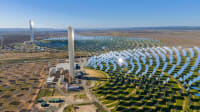What is Concentrated Solar Power and How It’s Affecting the Solar Sector
Insights
16 September 2025
Keisha Hunte

As the world pushes toward a greener energy future, solar power stands out as one of the most exciting options. You’ve probably seen those shiny blue panels on rooftops or spread across big fields. Photovoltaic (PV) panels, the most common form of solar technology, work by directly converting sunlight into electricity.
But another solar technology, Concentrated Solar Power (CSP), is quietly reshaping the industry, despite receiving far less attention than the PV panels.
Unlike PV panels, CSP doesn’t convert sunlight straight into electricity. Instead, it uses mirrors to concentrate sunlight into heat. That heat can be stored and later used to generate electricity, even after the sun has set. This ability to deliver clean power on demand makes CSP a powerful tool in the renewable energy toolkit.
What is CSP?
Concentrated Solar Power (CSP) works by capturing sunlight, turning it into heat, and then transforming that heat into electricity. The process begins with a field of mirrors, known as heliostats, which track the sun’s movement and direct its rays onto a central receiver. Inside the receiver is a heat-transfer fluid, often molten salt, that can handle extremely high temperatures. That intense heat boils water into steam, which drives a turbine connected to a generator to produce electricity. In other words, CSP makes electricity in the same way coal or gas plants do, just without the carbon emissions.
One of the most significant advantages of CSP is its built-in thermal energy storage. By storing heat in molten salt tanks, CSP plants can keep producing power for hours after the sun sets. This ability to deliver steady electricity, even at night, helps solve one of solar’s biggest challenges.
Types of CSP
CSP isn’t a one-size-fits-all technology. It comes in several designs, each built to work best in different conditions. The most common setup is the parabolic trough system, which utilizes long, curved mirrors that capture sunlight and direct it onto fluid-filled tubes. This design has been in use for decades and remains a preferred choice for many large-scale solar power plants.
Another popular option is the solar power tower, where thousands of heliostats focus sunlight onto a receiver at the top of a tall tower. Because it can reach much higher temperatures, this setup is perfect for both generating electricity and storing heat for later use.
There are also newer variations of CSP. Linear Fresnel reflectors use flat mirrors to imitate the parabolic trough effect at a lower cost. In contrast, dish Stirling systems use a satellite-style dish to concentrate sunlight and power a Stirling engine.
Regardless of the design, the principle remains the same: focus sunlight, convert it into heat, and use that heat to generate electricity.
Why CSP is a Big Deal
One of CSP’s biggest strengths is that it can keep the lights on even after the sun sets. With the help of thermal storage, CSP plant can deliver electricity day and night, an advantage that traditional PV panels cannot match without relying on costly battery systems. This makes CSP especially valuable for large-scale power grids in sun-rich regions like Spain, Morocco, and parts of the U.S.
But CSP isn’t just about electricity. The high temperature it produces can also support industries like desalination, mining, and manufacturing, where heavy-duty heat is essential. Since CSP produces energy with virtually no greenhouse gas emissions, it reduces dependence on fossil fuels while supporting sustainable industrial growth.
Challenges Holding CSP Back
Of course, CSP isn’t perfect. Some real hurdles have slowed the rate at which it’s catching on worldwide.
- High upfront costs: CSP plants are more expensive to build than traditional PV solar farms because of their complex design and large-scale infrastructure.
- CSP facilities often require large tracts of land in sunny, arid regions, along with water for cooling, a combination that can be difficult to secure in the very environments where CSP performs best.
- Weather dependence: CSP relies on direct sunlight. In areas with frequent cloud cover, efficiency drops sharply, making it less practical compared to PV systems.
Adding to these challenges, the rapid drop in PV costs has made it increasingly difficult for CSP to remain competitive at scale.
However, ongoing research and innovation are steadily reducing costs, improving storage, and exploring hybrid systems, keeping CSP in the race as a promising renewable energy option.
CSP vs. Photovoltaic (PV) Solar
Both Concentrated Solar Power (CSP) and Photovoltaic (PV) systems harness the sun’s energy. Still, they do it in very different ways.
- PV panels convert sunlight directly into electricity using semiconductor materials. They are highly versatile: suitable for rooftops, adaptable to urban spaces, and scalable into large solar farms. This flexibility makes them especially effective for small to medium-scale projects or in regions with variable sunlight.
- CSP systems use mirrors to concentrate sunlight into heat, and they convert that heat directly into electricity. This additional step enables CSP to incorporate thermal storage, allowing it to supply electricity even after sunset. CSP is best suited for large utility-scale plants where a steady, around-the-clock energy supply is critical.
Rather than competing, the two can make a great team; PV can handle the daytime, and CSP can step in after dark.
How CSP is Shaping the Solar Sector
CSP’s most considerable influence on the solar sector lies in energy storage innovation. By demonstrating how large-scale thermal storage can be integrated into renewable energy plants, CSP has inspired new approaches to grid reliability. Projects like Morocco’s Noor Power Station and the United States’ Ivanpah Solar Electric Generating System highlight how CSP can anchor national energy strategies.
Beyond storage, CSP is also driving diversification within the solar market. Instead of competing with PV, it increasingly serves as a complementary technology that strengthens renewable portfolios. With its ability to deliver consistent, dispatchable electricity, CSP addresses one of the most significant challenges in the shift to 100% renewable energy: ensuring grid stability.
The Road Ahead for CSP
The outlook for CSP is promising. As costs decline thanks to advances in materials, design, and hybrid systems, CSP is becoming more competitive. Hybrid plants that combine CSP with PV or other renewables are desirable, offering the best of both worlds: PV’s affordability and scale with CSP’s storage and reliability.
Countries with abundant sunlight are beginning to place CSP at the center of their long-term strategies. As global energy demand rises and the need for reliable, carbon-free power intensifies, CSP is expected to play an increasingly important role in the clean energy mix.
CSP might never match PV in sheer numbers. Still, its ability to deliver power on demand makes it a key piece of the renewable energy puzzle. Working alongside PV, CSP can help build a balanced, reliable, and sustainable energy system.
In the race toward 24/7 clean power, CSP shows that the sun’s potential doesn’t end when daylight does. Global Edge partners with companies across the energy sector to provide the workforce solutions that bring renewable technologies, including CSP, to life.

